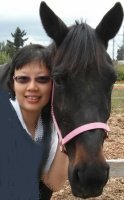
Club member Kevin with his therapy Standardbred horse and participants.
Animals In Therapy
Modern medicine is embracing a therapy that has evolved in popularity in which animals are viewed as
healing and assisting human beings generally known as Animal Therapy. Horses, dogs, cats, pigs
and many other animals are employed in Animal therapy.
Equine therapy
There are two main catagories in Equine Therapy: Riding and non-riding. These branch out into different methods depending on the end result desired. The Standardbred horses are ideal because of their gentle, safe and even temperaments. The Standardbred horses are not 'spooky' and are used to loud noises if they came from a trotter or pacing career where crowds at the race tracks could often become very excited and loud. The former race horses have also been handled since very young and are used to being haltered and groomed. Standardbreds are known for their reliable and kind dispositions.
Riding therapy
Riding therapy usually involves one horse and a rider with either a facilitator, therapist, or individuals where the horse's movements at the walk are considered beneficial for improvement in coordination and motor skills for the rider. Although there are variations in riding therapy and other desirable outcomes the basic objective is to stimulate and use specific muscle groups in the rider and develop social skills while in rapor with the horse. With different exercises the rider can also develop social skills and problem-solving skills. Standardbred horses are particularly well-suited for riding therapy because of their calm and safe natures.
Non-Riding therapy
Unlike riding equine therapy, non-riding equine therapy is a much newer therapy that
was started by the Club's founder, Felicia Allen, over fifty years ago with Standardbred
horses. Felicia named the therapy
the Equine Assisted Natural Healing program (EANH) which after many years is recognized as an effective, non-intrusive
and safe method to
compliment traditional medicinal practices and therapeutic treatments.
EANH was the first non-riding therapy program with horses established in Canada and internationally. The focus is on personal growth, healing, learning and ultimately wellbeing. EANH was developed by the program founder, Felicia Allen, (also the founder of the Standardbred Fan Club!) on a concept that she named Equine Intuitive Healing.
Felicia remembers the early days of her non-riding EANH therapy program, "People thought 'oh yeah, one of those coo-coo horse types' when I described the program. There just wasn't the concept five decades ago that horses had some qualities that we still can't fully comprehend however they are healing for us."

Equine Assisted Natural Therapy (EANH) horse and child
As the EANH program worked with children with autism, youth at risk, veterans with PTSD as an alternative therapy hand in hand with the medical profession, the views of the public began to change. Felicia recalls, "I remember that one day, about thirty years ago, a woman phoned and told me that she was starting a society that certifies non-riding therapists. I thought that was a major breakthrough and today therapists are certified in Non-riding therapy which is a popular therapy now."
Felicia has since closed her EANH therapy program since "the Standardbreds who paved the way for my work and had the special abilities and temperaments for a non-riding therapy horse are no longer living." However their contributions, particularly a little black Standardbred horse "Kootenay" (Martha Kootenay), nicknamed Cutie by the children taught Felicia about the horse's intuition, ability to understand and interpret our inner emotions and Felicia speaks fondly that "Kootenay is remembered by so many of the participants who became healed with her help."

In memory of Kootenay "Cutie" (Martha Kootenay)
who helped so many on their healing journey.
Finding a therapy horse
As one of the experts on Standardbred horses, being a trainer and an equine therapist, Felicia advises newcomers to riding therapy to look for "a former pacing race horse (Standardbred) with the stellar calm and gentle Standardbred personality. It will take time for the horse to fully trust you however the gift, when it arrives, is unmistakeable. You feel like a special person and that is because the horse will know that you truly are."
Thank you, Felicia, for understanding the need to help us explore the ability of the horse to communicate with us on a deep level by freely providing a 'narrative video' on your website. I often tell anyone who is interested about the seemingly magical between horse and human, but the 'right' words are elusive. The story you tell has helped me find those words!
Best, Cynthia Orman
If interested, there is more information on the Equine Assisted Natural Healing program on
www.EANH.ca
Hello, My name is Sarah and I work in the Surrey School District in the Safe Schools Dept. with youth at risk. I work closely with several young people who struggle with behaviour challenges, difficult home situations, and trouble making positive connections, and we feel very strongly about the connections that can be made with these youth and animals - horses in particular.
Sarah McKay, Manager, Safe Schools department, District of Surrey
The Standardbred horse is a wonderful companion to consider for equine therapy and is employed widely in
both the riding and non-riding therapies.
Other Articles
Standie Talents
Famous Standardbred Jumpers
Standardbred Riding
Trail Riding
Training A Standardbred
Members Stories





